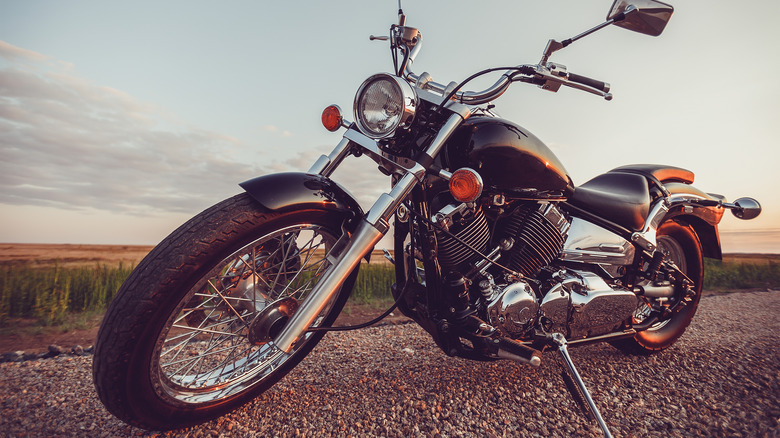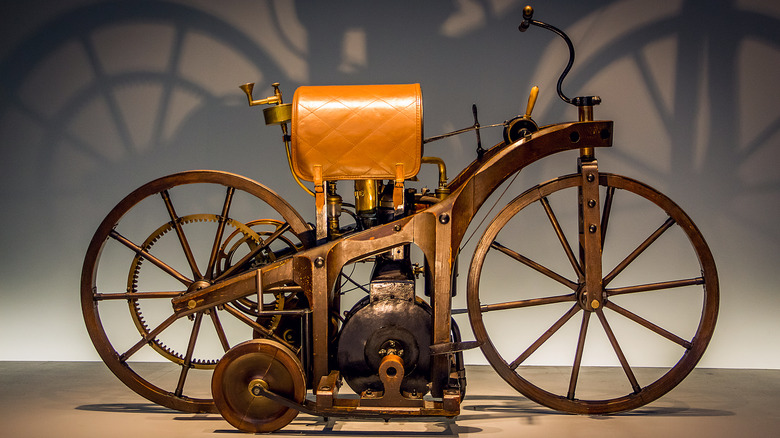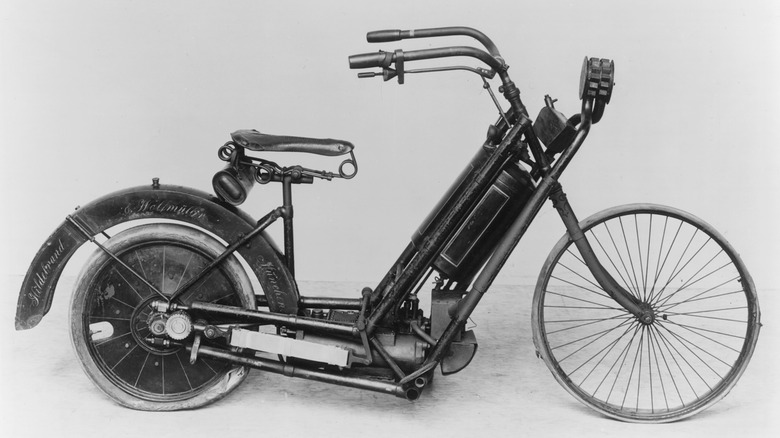The Murky Origins Of The Motorcycle
Motorcycles have had a place in the American zeitgeist since the dawn of the 20th century. The first motorcycles mass-produced on our shores was the Orient-Aster which was introduced in 1898 (via Motorcycle.com). Companies like Indian and Harley-Davidson weren't far behind when they began production in 1901 and 1902, respectively. Before the end of the first decade of the century, clubs were forming around the country (via Twisted Road).
The U.S. military was quick to recognize the value of the motorcycle. After proving their usefulness in the Mexican Expedition against Pancho Villa in 1916 (via Harley Davidson Forums), the military ordered tens of thousands of bikes for use in World War I, transforming Harley-Davidson into the largest motorcycle manufacturer in the world. World War II saw another surge in motorcycle production, and by the middle of the century, the motorcycle was firmly entrenched in the American psyche.
Today, we can trace the modern popularity of motorcycles back through time from "Sons of Anarchy" and "Terminator 2" to "Easy Rider" and "The Wild One" (via Footman James). What's less clear is who can claim to be the progenitor of the motorcycle.
I want to ride my bicycle
The bicycle — the fundamental precursor to the motorcycle — was born out of the most powerful volcanic explosion in recorded history. The 1815 eruption of Mount Tambora in Indonesia ejected so much ash into the atmosphere that the global temperature plummeted, leading to the Year Without a Summer in 1816. Without food for themselves or their animals, people in famine-stricken Europe were reduced to slaughtering their horses for food. In the face of this, an inventor named Karl Drais sought to create a means of human-powered propulsion. His solution was the pedalless Laufmaschine ("running machine"), essentially a primitive balance bike (via The Paris Review).
The initial popularity of human-powered, two-wheeled vehicles was short-lived until their revival in the 1860s when Pierre Michaux added pedals to the front wheel. In the 1870s the penny farthing bicycle evolved out of the desire of riders for more speed, which a massive front wheel could provide. In the 1880s — in an effort to overcome the safety problems of the penny farthing — the modern safety bicycle was invented with a chain-driven rear wheel and a seat low enough for the rider to be able to touch the ground (via History).
Fetch the engines
At the same time the bicycle was developing, ingenious minds across Europe were also pushing forward engine technology. When Drais was inventing his Laufmaschine, steam was fast becoming the dominant source of industrial power in Europe (via ThoughtCo). But, due to its low efficiency, many searched for a new engine technology.
After some false starts, Étienne Lenoir launched the first commercially successful internal combustion engine in 1860. Lenoir's two-stroke engine was improved upon by Nikolaus Otto's four-stroke engine in 1876 which found major commercial success (via Britannica). Two of Otto's employees — Gottlieb Daimler and Wilhelm Maybach — left the company to pursue their vision of a smaller, more powerful engine that could propel a cart (via The American Society of Mechanical Engineers).
By 1884 they had achieved their vision, developing the "grandfather clock" engine that could operate at 600 rpm, five times faster than Otto's engines. As a proof of concept, they created the Reitwagen, a wooden framed vehicle similar to a bicycle in that it had two large front and back wheels, as well as two smaller wheels on the sides. Many today consider this to be the first bicycle.
What is a motorcycle?
There's no question that Daimler and Maybach's new engines were instrumental in opening up the motor vehicle market, but whether or not it is the first motorcycle depends on what your definition of a motorcycle is. If the definition is an internal combustion engine–powered vehicle straddled by the rider, then the Reitwagen is clearly the first.
If, however, one's definition of motorcycle is looser, then it's not hard to find other contenders for the "first" motorcycle. If the internal combustion engine isn't considered essential, then either Sylvester Roper's or Ernest Michaux's (son of Pierre Michaux) steam-powered velocipedes could be considered a first (via Bicycle History).
There is one first that can be firmly established. The first mass-produced, gas-powered, internal combustion engine–driven, two-wheeled vehicle was made in 1894 by Hildebrand & Wolfmüller in Germany. Unlike the Reitwagen, this vehicle followed the established principles of bicycle design. Unlike the steam-powered velocipedes, it could achieve speeds of up to 30 mph. And, unlike any vehicle that came before, it was the first to be called a "motorcycle" (via The Henry Ford).



